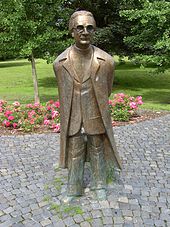Konrad Zuse
Zuse attended the Collegium Hosianum in Braunsberg, and in 1923, the family moved to Hoyerswerda, where he passed his Abitur in 1928, qualifying him to enter university.[23]: 418 Working in his parents' apartment in 1936, he produced his first attempt, the Z1, a floating-point binary mechanical calculator with limited programmability, reading instructions from a perforated 35 mm film.On 30 January 1944, the Z1 and its original blueprints were destroyed with his parents' flat and many neighbouring buildings by a British air raid in World War II.[18] In September 1940 Zuse presented the Z2, covering several rooms in the parental flat, to experts of the Deutsche Versuchsanstalt für Luftfahrt (DVL; German Research Institute for Aviation).In 1940, the German government began funding him and his company through the Aerodynamische Versuchsanstalt (AVA, Aerodynamic Research Institute, forerunner of the DLR),[25] which used his work for the production of glide bombs.However, Turing-completeness was never considered by Zuse (who was unaware of Turing's work and had practical applications in mind) and only demonstrated in 1998 (see History of computing hardware).The Z3, the first fully operational electromechanical computer, was partially financed by German government-supported DVL, which wanted their extensive calculations automated.A request by his co-worker Helmut Schreyer—who had helped Zuse build the Z3 prototype in 1938[29]—for government funding for an electronic successor to the Z3 was denied as "strategically unimportant".[23]: 428 On 3 February 1945, aerial bombing caused devastating destruction in the Luisenstadt, the area around Oranienstraße, including neighbouring houses.The partially finished, telephone relay-based Z4 computer was then packed and moved from Berlin on 14 February, arriving in Göttingen approximately two weeks later.[36] In 1947, according to the memoirs of the German computer pioneer Heinz Billing from the Max Planck Institute for Physics, there was a meeting between Alan Turing and Konrad Zuse in Göttingen.[44] Heinz Rutishauser, one of the inventors of ALGOL, wrote: "The very first attempt to devise an algorithmic language was undertaken in 1948 by K. Zuse.Donald Knuth suggested a thought experiment: What might have happened had the bombing not taken place, and had the PhD thesis accordingly been published as planned?[45] In 1967, Zuse suggested that the universe itself is running on a cellular automaton or similar computational structure (digital physics); in 1969, he published the book Rechnender Raum (translated into English as Calculating Space).







Horst ZuseZuse Institute BerlinHeliosturmBerlinPrussiaGerman EmpireHünfeldTechnische Universität BerlinPlankalkülCalculating Spacedigital physicsHelixturmWerner von Siemens RingHarry H. Goode Memorial AwardGeorge StibitzWilhelm Exner MedalOrder of Merit of the Federal Republic of GermanyComputer History MuseumComputer scienceComputer engineeringpioneering computer scientistTuring-completeprocess controlhigh-level programming languagecomputation-based universegovernment of Nazi GermanyWorld War IIERMETHEast PrussianBraunsbergPolandCollegium HosianumHoyerswerdaAbiturFord Motor CompanyHenschelSchönefeld near BerlinKreuzbergfloating-pointGerman Museum of Technologyvon Neumann architectureblueprintsBritish air raidmilitary servicerelaysglide bombsanalog-to-digital converterMehringdammbinaryTuring completeHistory of computing hardwareHelmut SchreyerBad Hersfeldvacuum tubesAllied Air raid in late 1943LuisenstadtGöttingenHs 293Hs 294cruise missileSoviet troopsmachine codeAllgäupost-war GermanyETH ZurichHeinz BillingMax Planck Institute for PhysicsAlan TuringcolloquiumWomersleyEduard StiefelHaunetal-NeukirchenUniversity of AugsburgALGOL 58Heinz RutishauseralgorithmicFree University of BerlinDonald Knuththought experimentplotterHanover FairFrieder Nakeuniversecellular automatonDeutsches MuseumretrocomputingSiemensNazi PartyFaustian bargainatheistMagnetic drumFritz LeonhardtWalter SchottkyBundesverdienstkreuzKonrad Zuse MedalGesellschaft für InformatikDeutsches TechnikmuseumJohn Vincent AtanasoffList of German inventors and discoverersReverse Polish notationSelf-replicating machineZ5 (computer)Z23 (computer)Z25 (computer)Springer ViewegSpringer Fachmedien Wiesbaden GmbHWayback MachineComputer Conservation SocietyScience Museum (London)Friedrich Vieweg & SohnMassachusetts Institute of TechnologyWorld ScientificThe GuardianSpode, HassoSpringer-VerlagMichael Imhof VerlagThe IndependentVDI-VerlagRobertson, Edmund F.MacTutor History of Mathematics ArchiveUniversity of St Andrews